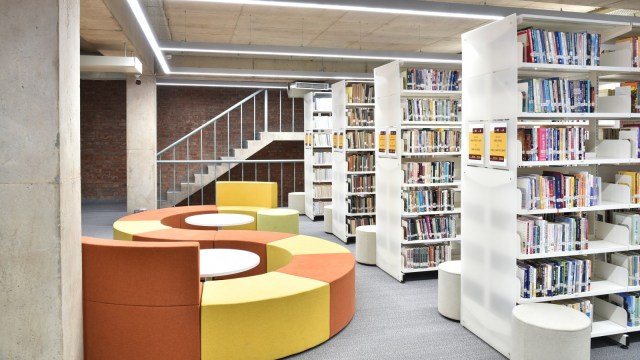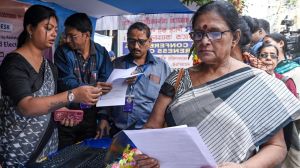Upgraded tech, refined databases and improved reading spaces; libraries in Gujarat become harbingers of change
These scenes are unfolding at the Vikram Sarabhai Library (VSL) of the Indian Institute of Management – Ahmedabad (IIM-A). The VSL has become a sought after spot since it was redesigned six years ago.
 The premier management and architecture institutes in Gujarat are keeping up with the pace by catching up on technology and upgrading their libraries. (Express Photo)
The premier management and architecture institutes in Gujarat are keeping up with the pace by catching up on technology and upgrading their libraries. (Express Photo)At one spot are students relaxing in a sleeping pod, some with their headphones on with eyes closed and feet stretched while the other spot is a witness to a vibrant discussion between a professor and the students. These scenes are unfolding at the Vikram Sarabhai Library (VSL) of the Indian Institute of Management – Ahmedabad (IIM-A).
The VSL has become a sought after spot since it was redesigned six years ago.
The premier management and architecture institutes in Gujarat are keeping up with the pace by catching up on technology and upgrading their libraries.
Although the daily visitors to the VSL library remain around 400 a day, the online reference queries have seen around three-fold increase in the last five years (2019-2023) from 5,315 to 15,059.
According to the institute, the queries through the online chat facility have also increased from around 800 queries a year to around 1000 in last five years. The usage of e-journals and databases at the institute has also doubled in the same period.
“As a higher education institution, it is crucial to embrace and leverage new technological advancements to disseminate knowledge, and libraries act as a pod that helps gather as well as share that. In the past few years, VSL has integrated various technology-driven services to keep up with global trends and evolving user expectations,” IIMA director Bharat Bhasker told The Indian Express.
 The digital collection of the library has over 150 databases, over 30,000 e-journals and over 2,90,000 e-books.
The digital collection of the library has over 150 databases, over 30,000 e-journals and over 2,90,000 e-books.
“Aligning itself with the broader goal of meeting the research, educational, and learning requirements of the IIMA community, VSL has evolved into a hybrid library. It has also enhanced the usage of the library by manifold. The use of different library spaces has seen a significant increase. Easy access to information has resulted in better research and learning outcomes,” Bhasker added.
According to the IIMA data shared with The Indian Express, the library has built a robust collection of over 2,50,000 items, including books, bound volumes, working papers, student project reports, and doctoral theses. The digital collection has over 150 databases, over 30,000 e-journals and over 2,90,000 e-books. The library is open 24×7.
Meeting diverse demands
The VSL, a part of the heritage campus of IIMA designed by the renowned architect Louis Kahn, is one of the few buildings restored. The restoration was completed in 2018. “While redesigning the library, community spaces were prioritised, and an entire level was set aside for them, with space for open group discussions as well as cabins with a variety of seating configurations to meet diverse demands. All closed group study areas have smart boards for interactive conversations,” said sources.
“Equal priority was given to silent reading spaces, individual study carrels, and reading lounges, allowing users to pick their own comfort zones for extended study sessions,” added the sources.
“Thinking about a library one gets an impression of books but this library is beyond that. The space is beautifully designed and offers not only private spaces but also conference rooms for group studies and discussions, lounges, sleeping pods. All these spaces give us a break from our sitting and studying routine of 18 hours,” Accelerated General Management Programme (AGMP) student Pari Bawskar told The Indian Express.
Sai Charan, a second-year PGP student, an engineer from Indian Institute of Technology Kharagpur said, “Now, I prefer sleeping pods over my dorm room. The library is aesthetically the best I have seen so far.”
Another crucial component of the library is the high-performance computers fitted with the latest software, allowing users to access important databases. The online chat feature is utilised to maintain communication with the users, while services like RemoteXS and the Android App offer convenient access to essential information. The library has implemented several technologies, including RFID for seamless print resource transactions, Assistive Technology such as JAWS (Job Access With Speech), SARA CE, and KIBO to provide inclusive reading environments for visually challenged people.
 Another crucial component of the library is the high-performance computers fitted with the latest software, allowing users to access important databases.
Another crucial component of the library is the high-performance computers fitted with the latest software, allowing users to access important databases.
Increase in users
A huge jump in users with the technological advancements has been witnessed at the Knowledge Exchange and Information Centre (KEIC) at MICA Ahmedabad. “The online download numbers have increased from 7,741 (in 2019) to 20,903 (in 2023) whereas physical visits increased from 10908 (in 2019) to 13360 in (2023),” Librarian at MICA, Dr Chintan Pandya said. Pandya earlier visited several leading institutions such as the American Library Association (ALA) in Chicago, OCLC in Dublin, University of Ohio, University of Chicago, and the Abraham Lincoln Museum in Springfield as part of an international programme.
Reflecting on his experience, Pandya said, “The passion for gathering information can be maximised by bringing technology into our libraries and providing readers with a user-friendly space. It is crucial for librarians to assume responsibility for educating both young and old individuals about digital citizenship and digital literacy.”
Ahmedabad MICA Director and CEO Jaya Deshmukh said the MICA library users have increased in the past five years.
“While all the content is also digitally available for our students, leafing through physical copies in a calm environment completes the reading experience. To be thriving and relevant, libraries today have to provide personalised content in line with the expectations of digital natives, incorporating all the efficacies of AI while being mindful of ethical usage”, said Deshmukh.
Lauding the efforts of the library team to assign bilingual translators, Deshmukh said, “Our library will soon have assistive technology for people with disabilities. The scanner will make the content digitally inclusive and enable users to listen, translate and digitise documents in over 100 languages”.
 Sleeping pods at Vikram Sarabhai Library in IIMA.
Sleeping pods at Vikram Sarabhai Library in IIMA.
MICA alumni from the 2022 batch, Jai Shrivastava, currently working with Google said, “During my time at MICA, the KEIC library’s online resources were indispensable, especially during Covid. KEIC provided full access to powerful tools such as Statista, JSTOR, and IBEF, which were crucial in understanding market trends and forecasts.
I remember studying the future of AI and its impact on marketing when AI was just being introduced. The KEIC resources helped me prepare for my final placements.”
While KEIC is among the few libraries to implement WINISIS based book circulation system, it also maintains an institutional digital repository. During the placement season, the library offers the students a compilation of daily industry updates and relevant news.
Reliance on library services
Similarly, at CEPT University, librarian Dr Hayat Ahmad shares how there was a 56 per cent increase in both hits and downloads of online resources between the 2021-2022 and 2022-2023 fiscal years. “We have observed an 88.16 per cent increase in online reference queries and Document Delivery Service requests over the last two academic years, all resolved promptly, increasing user satisfaction and reliance on library services. This is a trend that was accelerated by Covid pandemic”, said Ahmad.
The library houses over 60,000 resources, including books, journals, theses, databases, and digital materials. “The first preference of students is the pods, the personal space which is quieter and where you can control the lights. This area gets occupied quickly,” Simran Gandhi, a postgraduate final year student at CEPT said.
 The library houses over 60,000 resources, including books, journals, theses, databases, and digital materials.
The library houses over 60,000 resources, including books, journals, theses, databases, and digital materials.
Recently, the CEPT University library got an app that offers seamless, 24/7 access to a comprehensive collection of e-resources.
Johannes Senn, an international student under CEPT University’s exchange programme from Switzerland is impressed with the vast e content options available at the library. “Not to miss the centrally air conditioned facility on all the floors,” Senn added.
“The library has expanded its digital collection, adding hundreds of eBooks(124 reference books), digitising over 8,000 UG and PG theses, and participating in the Shodhganga project,” Dr Ahmad added.







